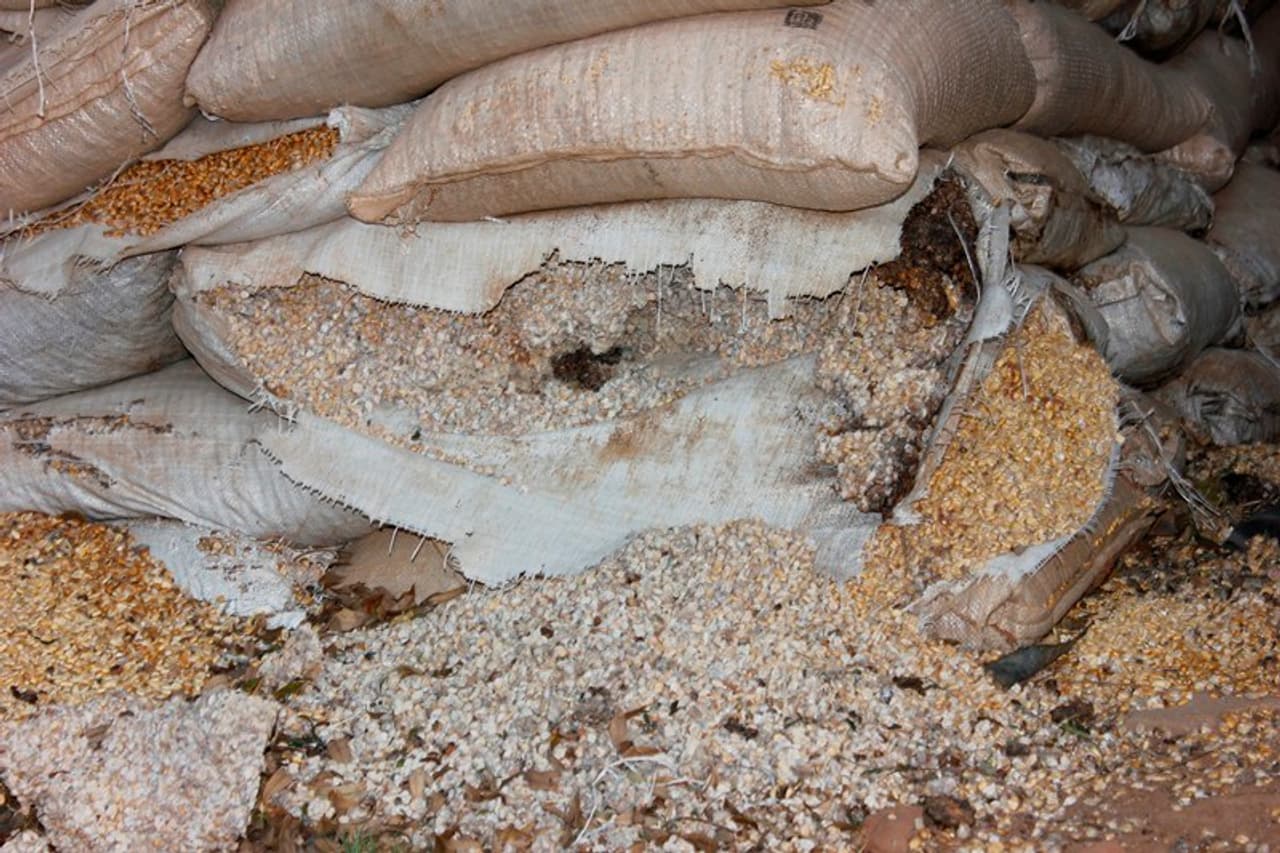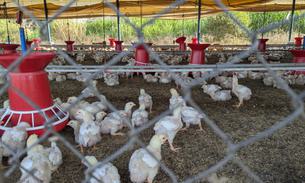
Government-owned corn destroyed in one of Africa’s poorest countries
A rotten shame. Maize goes to waste in a government warehouse in Mkushi, Zambia. (photo by Brian Malama)
In a government warehouse in the centre of one of Zambia’s farming districts, 300 miles from the capital, thousands of bags of corn are stacked up high. All are rotten. All are set to be destroyed.
This destruction of food is a calamity for a country where the UN estimates 64% of its people are still incapable of placing two meals on the table. In Zambia, the average rural farmer is estimated to survive on less than $2 per day.
The Mkushi warehouse, where 50,000 bags have gone to waste and another 200,000 are in danger of going bad, is not an isolated case. Across the poor African country hundreds of thousands of tonnes of maize are being rotting away or being destroyed.
Officially 54,235 metric tonnes of maize is earmarked for destruction countrywide, but other experts have suggested that figure could top 100,000 tonnes by the end of the harvest.
The Zambian government simply does not have enough storage facilities nor is there an adequate road network to transport maize, most of which is grown by smallhold farmers living in remote, rural areas.
Vice President Guy Scott admitted during a June media briefing that: ‘We have two million tonnes of maize against storage facilities that are meant for 300,000 tonnes of maize, so with poor storage it gets rotten.’
Controversial payment
At the heart of the problem are controversial government subsidies including a programme which provides cheap fertiliser to farmers growing maize and a government policy to then buy the crop at above-market rates.
Maize, from which the porridge-like paste nshima is made, is consumed in vast quantities in Zambia. Government subsidies, introduced by the late President Levy Mwanawasa in 2004 to ensure the country grew enough of its own food, have encouraged farmers to boost their maize production.
The policy has been so successful that the country has turned itself from an importer of food to an exporter. And as the world worries about the the impact on food prices of the devastating US drought, the Zambian government as a result of its polices has a different concern – how to deal with the maize that is spilling out of government silos and other storage facilities. Even schools have reportedly been converted into makeshift warehouses to deal with the overflow.

The Food Reserve Agency (FRA) is aware of the storage constraints according to a statement on its website and is making efforts to ‘engage relevant authorities on the matter so that funds could be mobilised to support construction of additional storage facilities, as well as rehabilitating the existing ones.’
It has drawn up an investment plan to construct new facilities with a total storage capacity of ‘700,000 metric tonnes in various parts of the country, which have been recording increasing production but with inadequate storage,’ it added. It has not said how much this will cost.
In addition, the FRA has leased storage facilities from the private sector and over 200,000 metric tonnes of capacity has been utilised so far says Mwamba Siame, an FRA spokeswoman in a statement posted on the agency website.
Reducing poverty
Zambia moved to increase its food production back in 2004 following a hugely problematic food crisis in 2002. Further hit by the spike in world food prices in 2008 when the cost of maize increased by more than 100% compared to 2006, the government again sought to increase production.
The new government has continued to subsidise maize production to the tune of $471,698 per year according to a study, The Fiscal Cost of Existing Maize Policies (FCEMP) by NGO, the Indaba Agricultural Policy Research Institute commissioned by DFID. The subsidies have pushed up maize production from below 700,000 tonnes to nearly 3m this year.
It seems the policy has worked – at least in terms of assuring Zambia’s food security. But the subsidies are also aimed at reducing poverty, and by this measurement, many argue they have failed. The situation in Zambia provides a stark case study for just how difficult and complex a problem poverty reduction is.
Harsh critics
Earlier this year the World Bank urged the Zambian government to stop subsidising the maize crop, saying it was unsustainable longterm and not addressing the core problem – feeding the poor.
‘Current maize prices encourage mono cropping at the expense of crop diversification. Job creation through economic diversification, which is the goal of this government, is unlikely to be achieved if government pursues the same policy in the agriculture sector as that of the previous government. This old policy has not resulted in significant reduction in rural poverty and job creation.’
Instead the World Bank has suggested that the country’s poor would benefit more if the government allowed the market to set the price of maize: ‘It is our hope that Government will reconsider its policy in setting prices for maize to allow prices to be determined by prevailing market conditions. This will ensure affordable mealie meal prices for the low income households. Lower prices will not only reduce the cost of living for the poorer Zambians but will also benefit the livestock industry. Low prices will also contribute to the development of a sustainable maize export business, which will allow Zambia to become the bread basket in the region.’
Earlier this year the World Bank urged the Zambian government to stop subsidising the maize crop, saying it was unsustainable longterm and not addressing the core problem.
A report by the IMF, another critic of the subsidies, points out that the combined costs of the marketing and fertilizer support programmes have grown from 1.2% of GDP in 2009 to 2.7% in 2011.
Others have suggested that the programmes have not helped the most vulnerable members of the population – those that the policies were first aimed at. The report by IAPRI shows that Zambia has nearly 1.5m smallholder farmers. It is this rural population that makes up the majority of the country’s poor. But the study shows that the smallest farmers, those farming less than one hectare, increased their maize the least, by an average of just three 50kg bags. The farmers that benefited the most from subsidised fertilizer were those that farmed over five hectares.
It is the same with the government’s policy of buying maize at a premium – as two thirds of smallhold farmers do not sell their maize crop there are few that benefit from this government handout.
And even dealing with the surplus has proved a problem. A study by the Food Security Research Project (FSRP) entitled: Who gained and who lost from Zambia’s Maize Marketing Policy says that Zambian maize bought above market value at about $12 for a 50kg bag or about $300 per tonne meant it off loads onto the local and export market at a loss.
The rural poor
For critics, the money spent subsidising farming would be much better spent on other things targeted at the rural poor. The IAPRI, for instance, suggests that with the same amount of money more than 50 new high schools could be constructed and 10,000 more teachers employed. The number of health workers could be doubled for instance.
All these suggestions look good on paper but what would their full ramifications be if the government were to bite the bullet, cut subsidies and leave the maize marketing to market forces?
The almost 600,000 small scale farmers belonging to the influential Zambia National Farmers Union (ZNFU) that currently depend on in-put subsidies in the form of fertiliser and seed would be practically jobless and exert further pressure on the government to take care of them says Coillard Hamusimbi, an Outreach and Administration Manager at the almost million strong farmers lobby group ZNFU.
‘If the subsidies were removed,’ said Hamusimbi, ‘Zambia would start importing maize on a large scale at a bigger cost. We will experience runaway inflation as 60% of our inflation is directly attributed to food… there could also be a risk of small scale farmers losing a source of income so I don’t think the union would recommend the removal of subsidies… It’s unfathomable.’
The jury is still out on what the new Sata government will do. But as the harvest rolls in, the government must first grapple with the overflow and the difficult headlines as the reports of wasted stocks keep flooding in.
Anthony Mukwita is deputy managing director of the Zambia Daily Mail based in Lusaka. Earlier this year he spent three months on secondment with the Bureau.



